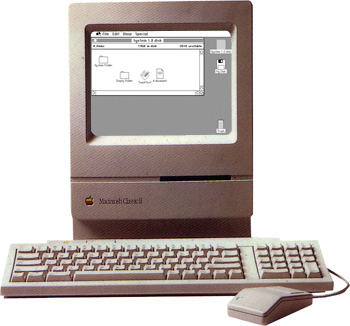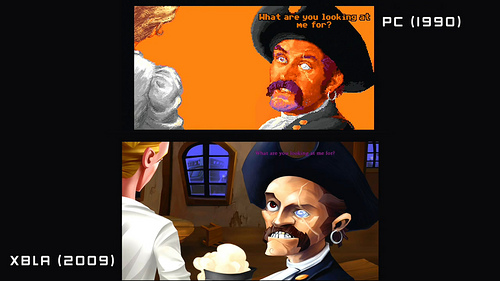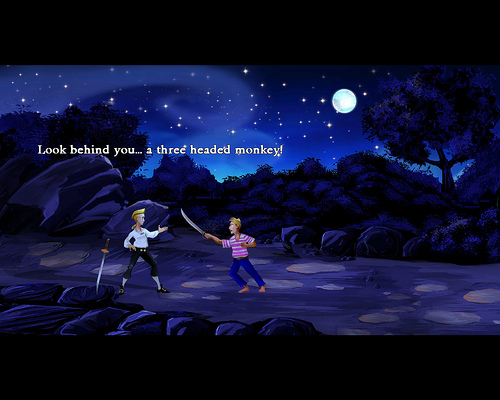This post has not been edited by the GamesBeat staff. Opinions by GamesBeat community writers do not necessarily reflect those of the staff.
Author’s note: As this is the first review I’ve written for Bitmob (not to mention the first review I’ve written in over 10 years), I figured an explanation of my review style was in order, which you can find here.
 Looking back on my formative gaming years, one of the great regrets I have is that, thanks to my father, we were a Macintosh family. He first became enamored with the Mac at work and eventually brought one home – our first computer, in 1990, was a black-and-white Mac Classic.
Looking back on my formative gaming years, one of the great regrets I have is that, thanks to my father, we were a Macintosh family. He first became enamored with the Mac at work and eventually brought one home – our first computer, in 1990, was a black-and-white Mac Classic.
As anybody with a Mac can tell you, there is one universal fact that’s as true today as it was back then – even though we never had to bother with with DOS, the endless bootup times of early Windows releases, or numerous BSoDs…they just don’t make that many games for Mac.
When I was able to tear myself away from my NES, I made do as best I could – at the very least, I could play Risk, Tetris, Sim City, and the curious game Lunatic Fringe (that was, for some reason, included in the screensaver collection After Dark).
But really, as far as home PC gaming was concerned, that was what I was stuck with – while the wide world of Windows and DOS gaming passed right by me like a highway driver zooming past a forlorn hitchhiker, his outstretched thumb obscured by a cloud of dust.
Naturally, when I heard that Secret of Monkey Island – one of the legendary classics of the point-and-click adventure genre – was being remade and coming to Xbox Live Arcade, I was stoked.
I had managed to get into some of the adventure classics on our Macs – Myst and The Dig being the biggies – so I was eager to finally see what else I’d missed during those turbulent 90’s. After giving the trial a quick spin, I coughed up the 800 points and started the game proper.

The first thing that you notice upon starting the game is the gorgeous widescreen HD artwork. It’s especially impressive when you hit the back button on the 360’s controller to switch the game to Classic Mode, where you can see what it originally looked like back in the 90’s in all its pixellated glory (and get a 5-point achievement! Whee!).
The voice acting that LucasArts added, principally using the original voice actors from the later Monkey Island games, ranges from very good to excellent, with some voices that will sound very familiar to longtime gamers and/or cartoon watchers (such as Cam Clarke and Rob Paulsen).
The controls make the transition from mouse to controller mostly intact, and are very intuitive. The cursor, which is moved around with the analog stick, contextually shows whatever automatic action will be done by pressing the A button, while the B button is also contextually mapped to a probable secondary action which often comes in very handy.
Menus with your inventory and the full “verb map” used by the SCUMM engine are mapped to the left and right triggers, and the verb map can also be accessed by pressing specific directions on the d-pad, like the hotkey system from Oblivion and Fallout 3.
The gameplay is standard adventure game fare – talk to NPCs to receive quests, pick up items to solve the puzzles in said quests, rinse, repeat. There’s nothing particularly new or revolutionary gameplay-wise, even by 1990 standards, but the reason why this game became such a cult hit over the years is its clever writing.
 Humor permeates every inch of this game -there are some truly terrible, groan-inducing puns for puzzle answers, the main character’s (the unforgettably named Guybrush Threepwood) observations on the world he finds himself in are pithy and amusing, and the “insult swordfighting” I’d heard so much about was as good as advertised. However, that unfortunately does not describe the whole game.
Humor permeates every inch of this game -there are some truly terrible, groan-inducing puns for puzzle answers, the main character’s (the unforgettably named Guybrush Threepwood) observations on the world he finds himself in are pithy and amusing, and the “insult swordfighting” I’d heard so much about was as good as advertised. However, that unfortunately does not describe the whole game.
When I mentioned earlier that the gameplay was standard adventure game fare, I meant it. What that means is that like any other adventure game, there’s a requisite amount of time that requires you to wander around having no damned idea of what to do next, and exhausting every single possibility you can think of still gets you nowhere.
The game does include a hint system, but it’s pretty hit or miss – at one point I was on a ship with a locked hatch on one end, and a key I couldn’t reach on the other. After trying just about everything I could think of at the time, I asked for a hint, and received “You need to open that hatch.” Bemused, I asked for another one, and got the even more helpful “You need to go get the key.” ARRRGH!
On top of that, the control system and I didn’t always see eye to eye. I’d say that about 20% of the time I called up the inventory menu and hit A to look at one of my items, the window would disappear like it was supposed to, but nothing else would happen.
Some of the timed events that you’re required to pull off, calling up multiple menus on multiple items, are not particularly easy to pull off, and the baffling layout of the verb menu with regards to the 360’s d-pad made no sense – why on earth is the ubiquitous “Use” command on one of the d-pad’s notoriously poor diagonals when “Push”, which is used all of twice in the game, commands one of the coveted cardinal directions?
Now, call me old-school if you wish, but sometimes when companies update retro games and change the look significantly, I actually prefer the old way. There’s something odd about the way the HD characters move – their movements are eerily stiff and they look like they’re gliding instead of walking.
There’s just something…inorganic about the look, especially when compared to the old graphics, not to mention that I definitely preferred the more realistic art style of the original to the exaggerated cartoonish look of the remake.

On the same token, I appreciate that LucasArts recorded all-new voice acting for this game, as well as gave us the opportunity to switch back and forth from the old to the new on the fly, but that presented its own set of problems.
The original jokes were meant to be read, and at a certain pace at that – by shoehorning the voice clips into the same timeframe afforded to the old text lines, the end result is oddly stilted conversations with lots of excess pauses, and the comedic timing for many of the spoken lines is ever-so-slightly off-kilter.
With all these complaints, I’m sure you’re expecting a score of Dislike or Hate for my inaugural Bitmob review…but not so fast! Any game that causes me to excitedly call out to my wife the latest joke or pun I’d encountered, in addition to having as one of its items a rubber chicken with a pulley in it (to which Guybrush quips “What the heck could this possibly be used for?”), can’t be all bad. I’m looking forward to the next rerelease in the series, as well as checking out the all-new Tales of Monkey Island when it hits XBLA as well.
Final Score: Liked It!
